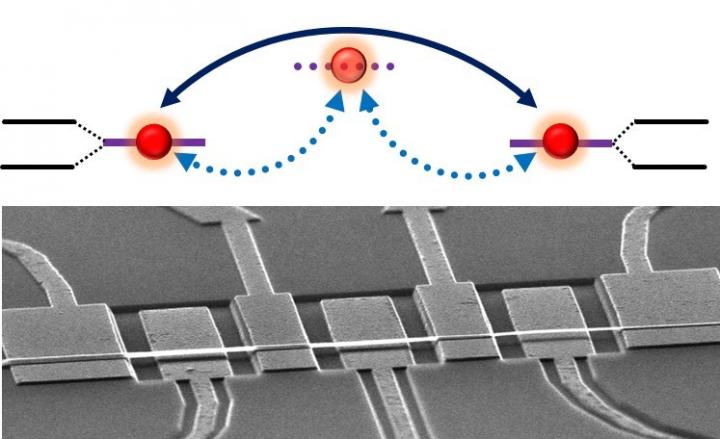USTC realizes strong indirect coupling in distant nanomechanical resonators

Schematic and scanning electron microscopy image of device architecture with a chain of three graphene-based nanomechanical resonators. Credit: @ university of science and technology of china
With the advantages of small size, stability and high quality factors, nanomechanical resonators are considered as a promising candidate to storage, manipulate and transfer information. Both classical and quantum information can be encoded on phonon states of mechanical resonators.
Phonon states can also transfer such information. Because of the rapid development of quantum acoustics, it is attracting more and more research interests. Huge amount of theoretical and experimental work have been done on connecting different systems, storing and transferring information via phonon states. [2]
The main problem of using nanomechanical resonator as information carrier is the realization of tunable phonon interaction at long distance. Many research groups around the world did a lot of studies on this problem. The most common way is to use optical cavities or superconducting microwave resonators as mediators. However, the difference between resonant frequencies of mechanical resonators and optical cavities or microwave resonators is too large. Also, the coupling strengths between them are relatively small, and hard to reach strong coupling regime.
Focusing on this problem, researchers proposed to employ mechanical resonator itself to act as a phonon cavity to replace the optical cavity or microwave resonator. The resonant frequencies of phonon cavity and mechanical resonators as information carriers are in the same range. Thus, these modes can be effectively coupled together. Previously, GUO's group realized strong coupling between neighboring mechanical resonators and coherent manipulation of phonon modes. [3, 4]
Based on these work, scientists designed and fabricated a linear chain of three graphene-based nanomechanical resonators, as shown in Fig. 1. In this device, the resonant frequency of each resonator can be tuned in a wide range via local bottom metal gates. Such tunability provides the possibility to realize and modulate the coupling between resonators in different frequency ranges. Firstly, they observed the mode splitting of each neighboring resonators.
It is found that in this structure, neighboring resonators are strongly coupled. Such results provide foundations for the study on the coupling between the first and the third resonator. When the resonant frequency of the center resonator is tuned near to that of the side resonators, large mode splitting can be observed. Also they found that the splitting can be widely tuned via tuning the resonant frequency of center resonator.
This phenomenon is similar to Raman process in optics. The center resonator can be regarded as a mediating state, the phonon modes of side resonators can achieve effective coupling via exchanging virtual phonon with the mediating state (Fig. 1). Using the theoretical model of optical Raman process, they got the relation between effective coupling strength and detuning. The experiment data agrees well with the theoretical results.
It is the first time to experimentally realize non-neighboring coupling in graphene-based nanomechanical resonators, and shed light on the studies of nanomechanical resonators. With the development of the studies on phonon states cooling, this work provides the foundation for storage and transfer of quantum information via phonon modes.
###
The co-first authors of this work is Dr. LUO Gang and Mr. ZHANG Zhuozhi from CAS Key Laboratory of Quantum Information. This work is supported by the Ministry of Science and Technology, National Natural Science Foundation of China, Chinese Academy of Sciences, Ministry of Education, National Natural Science Foundation of United States, University of California and the USTC Center for Micro and Nanoscale Research and Fabrication.
Reference
[1] G. Luo, Z.-Z. Zhang, G.-W. Deng, H.-O. Li, G. Cao, M. Xiao, G.-C. Guo, L. Tian, and G.-P. Guo, Strong indirect coupling between graphene-based mechanical resonators via a phonon cavity, Nature Commun. 9, 383 (2018). https:/
[2] L. Tian, Optoelectromechanical transducer: reversible conversion between microwave and optical photons, Ann. Phys. (Berlin) 527, 1 (2015).
[3] G-W. Deng, D. Zhu, X-H. Wang, C-L. Zou, J-T. Wang, H-O. Li, G. Cao, D. Liu, Y. Li, M. Xiao, G-C. Guo, K-L. Jiang, X-C. Dai, G-P. Guo, Strongly coupled nanotube electromechanical resonators, Nano Lett. 16, 5456 (2016).
[4] D. Zhu, X-H. Wang, W-C. Kong, G-W. Deng, J-T. Wang, H-O. Li, G. Cao, M. Xiao, K-L. Jiang, X-C. Dai, G-C. Guo, F. Nori, G-P. Guo, Coherent phonon Rabi oscillations with a high frequency carbon nanotube resonator, Nano Lett. 17, 915 (2017).
Media Contact
All latest news from the category: Physics and Astronomy
This area deals with the fundamental laws and building blocks of nature and how they interact, the properties and the behavior of matter, and research into space and time and their structures.
innovations-report provides in-depth reports and articles on subjects such as astrophysics, laser technologies, nuclear, quantum, particle and solid-state physics, nanotechnologies, planetary research and findings (Mars, Venus) and developments related to the Hubble Telescope.
Newest articles

NASA: Mystery of life’s handedness deepens
The mystery of why life uses molecules with specific orientations has deepened with a NASA-funded discovery that RNA — a key molecule thought to have potentially held the instructions for…

What are the effects of historic lithium mining on water quality?
Study reveals low levels of common contaminants but high levels of other elements in waters associated with an abandoned lithium mine. Lithium ore and mining waste from a historic lithium…

Quantum-inspired design boosts efficiency of heat-to-electricity conversion
Rice engineers take unconventional route to improving thermophotovoltaic systems. Researchers at Rice University have found a new way to improve a key element of thermophotovoltaic (TPV) systems, which convert heat…



